System Requirements for a Learning Application
VerifiedAdded on 2022/12/19
|10
|2625
|46
AI Summary
This report outlines the system requirements for a learning application that aims to revolutionize the learning experience and increase efficiency for instructors and students. It covers hardware and software requirements, functional and non-functional requirements, and the agile system development methodology.
Contribute Materials
Your contribution can guide someone’s learning journey. Share your
documents today.
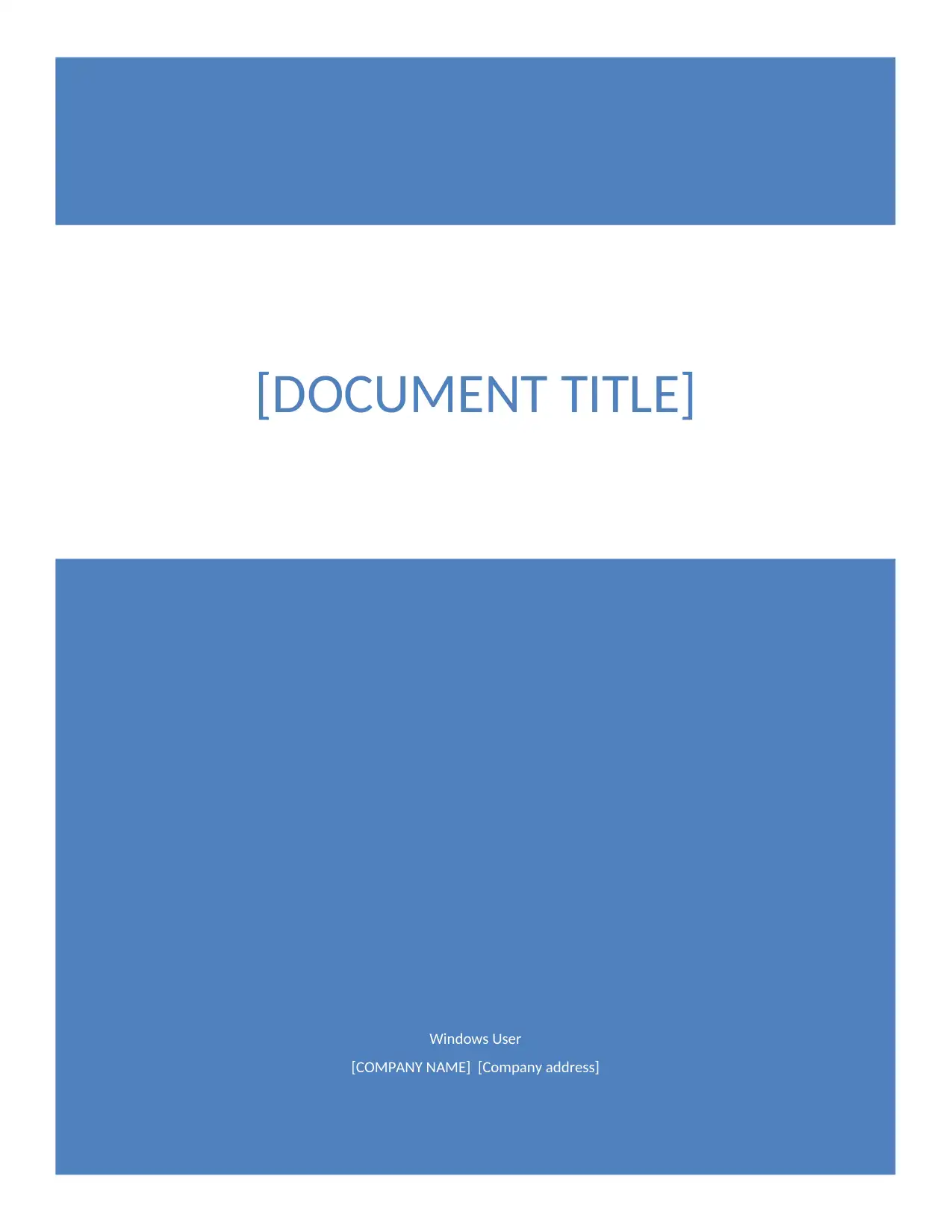
Windows User
[COMPANY NAME] [Company address]
[DOCUMENT TITLE]
[COMPANY NAME] [Company address]
[DOCUMENT TITLE]
Secure Best Marks with AI Grader
Need help grading? Try our AI Grader for instant feedback on your assignments.
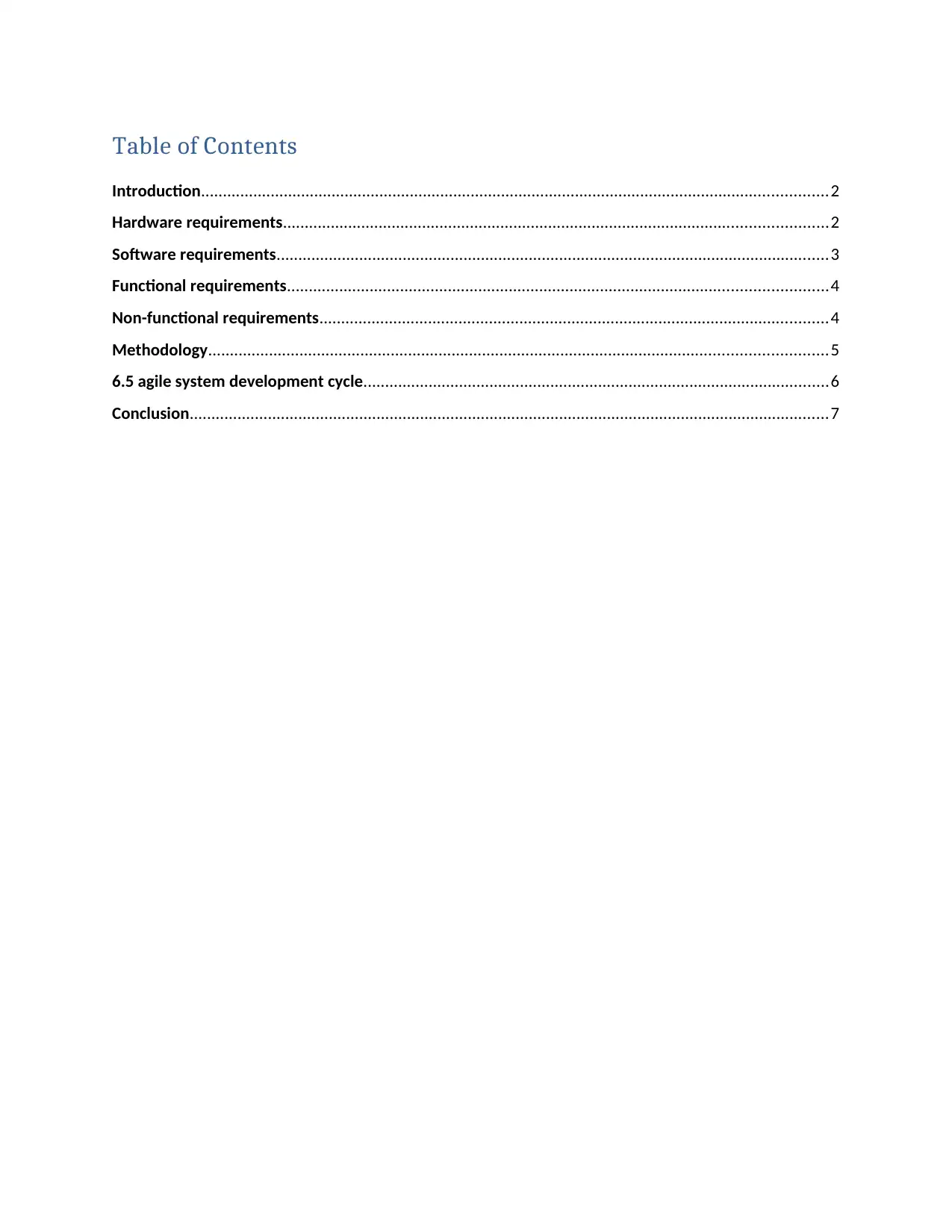
Table of Contents
Introduction................................................................................................................................................2
Hardware requirements.............................................................................................................................2
Software requirements...............................................................................................................................3
Functional requirements............................................................................................................................4
Non-functional requirements.....................................................................................................................4
Methodology..............................................................................................................................................5
6.5 agile system development cycle...........................................................................................................6
Conclusion...................................................................................................................................................7
Introduction................................................................................................................................................2
Hardware requirements.............................................................................................................................2
Software requirements...............................................................................................................................3
Functional requirements............................................................................................................................4
Non-functional requirements.....................................................................................................................4
Methodology..............................................................................................................................................5
6.5 agile system development cycle...........................................................................................................6
Conclusion...................................................................................................................................................7
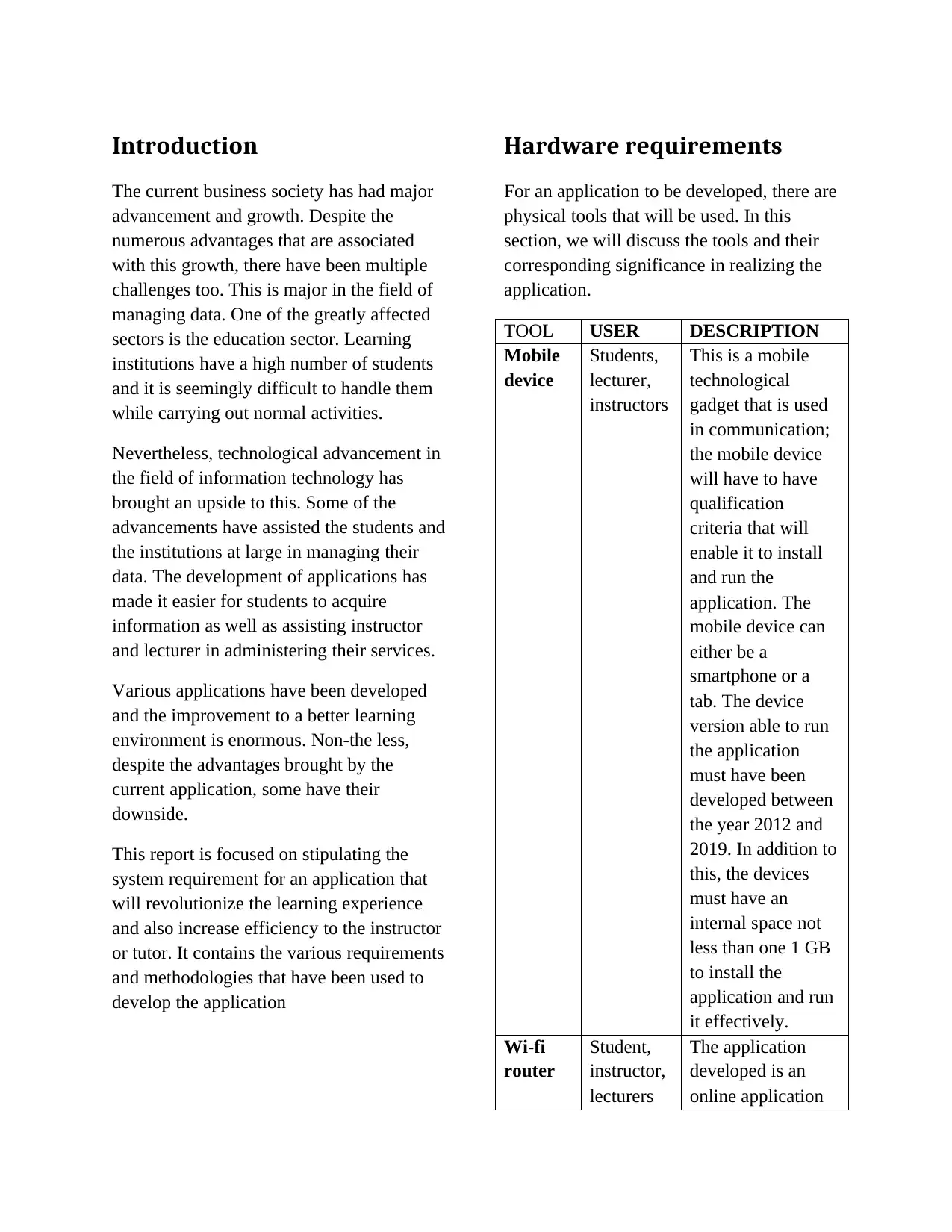
Introduction
The current business society has had major
advancement and growth. Despite the
numerous advantages that are associated
with this growth, there have been multiple
challenges too. This is major in the field of
managing data. One of the greatly affected
sectors is the education sector. Learning
institutions have a high number of students
and it is seemingly difficult to handle them
while carrying out normal activities.
Nevertheless, technological advancement in
the field of information technology has
brought an upside to this. Some of the
advancements have assisted the students and
the institutions at large in managing their
data. The development of applications has
made it easier for students to acquire
information as well as assisting instructor
and lecturer in administering their services.
Various applications have been developed
and the improvement to a better learning
environment is enormous. Non-the less,
despite the advantages brought by the
current application, some have their
downside.
This report is focused on stipulating the
system requirement for an application that
will revolutionize the learning experience
and also increase efficiency to the instructor
or tutor. It contains the various requirements
and methodologies that have been used to
develop the application
Hardware requirements
For an application to be developed, there are
physical tools that will be used. In this
section, we will discuss the tools and their
corresponding significance in realizing the
application.
TOOL USER DESCRIPTION
Mobile
device
Students,
lecturer,
instructors
This is a mobile
technological
gadget that is used
in communication;
the mobile device
will have to have
qualification
criteria that will
enable it to install
and run the
application. The
mobile device can
either be a
smartphone or a
tab. The device
version able to run
the application
must have been
developed between
the year 2012 and
2019. In addition to
this, the devices
must have an
internal space not
less than one 1 GB
to install the
application and run
it effectively.
Wi-fi
router
Student,
instructor,
lecturers
The application
developed is an
online application
The current business society has had major
advancement and growth. Despite the
numerous advantages that are associated
with this growth, there have been multiple
challenges too. This is major in the field of
managing data. One of the greatly affected
sectors is the education sector. Learning
institutions have a high number of students
and it is seemingly difficult to handle them
while carrying out normal activities.
Nevertheless, technological advancement in
the field of information technology has
brought an upside to this. Some of the
advancements have assisted the students and
the institutions at large in managing their
data. The development of applications has
made it easier for students to acquire
information as well as assisting instructor
and lecturer in administering their services.
Various applications have been developed
and the improvement to a better learning
environment is enormous. Non-the less,
despite the advantages brought by the
current application, some have their
downside.
This report is focused on stipulating the
system requirement for an application that
will revolutionize the learning experience
and also increase efficiency to the instructor
or tutor. It contains the various requirements
and methodologies that have been used to
develop the application
Hardware requirements
For an application to be developed, there are
physical tools that will be used. In this
section, we will discuss the tools and their
corresponding significance in realizing the
application.
TOOL USER DESCRIPTION
Mobile
device
Students,
lecturer,
instructors
This is a mobile
technological
gadget that is used
in communication;
the mobile device
will have to have
qualification
criteria that will
enable it to install
and run the
application. The
mobile device can
either be a
smartphone or a
tab. The device
version able to run
the application
must have been
developed between
the year 2012 and
2019. In addition to
this, the devices
must have an
internal space not
less than one 1 GB
to install the
application and run
it effectively.
Wi-fi
router
Student,
instructor,
lecturers
The application
developed is an
online application
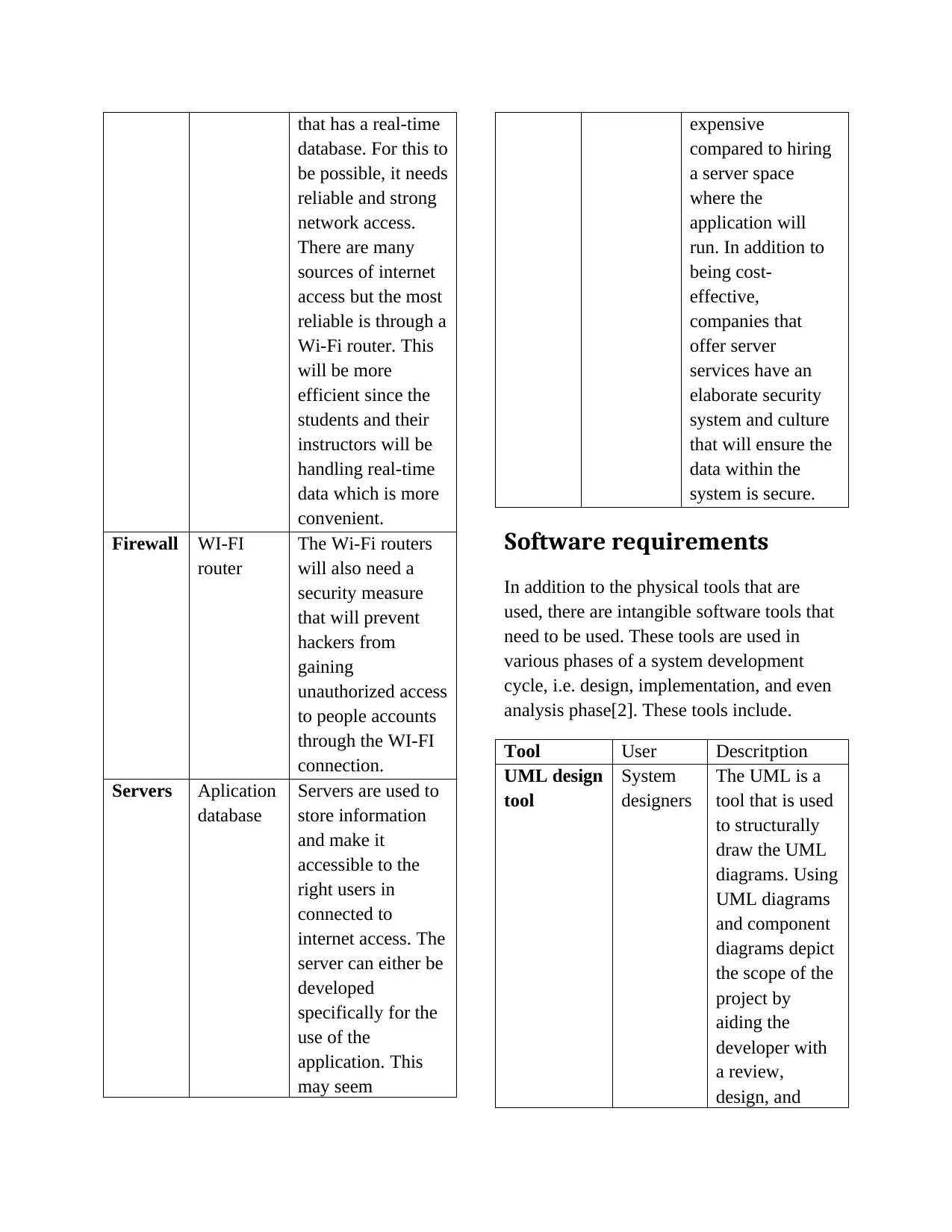
that has a real-time
database. For this to
be possible, it needs
reliable and strong
network access.
There are many
sources of internet
access but the most
reliable is through a
Wi-Fi router. This
will be more
efficient since the
students and their
instructors will be
handling real-time
data which is more
convenient.
Firewall WI-FI
router
The Wi-Fi routers
will also need a
security measure
that will prevent
hackers from
gaining
unauthorized access
to people accounts
through the WI-FI
connection.
Servers Aplication
database
Servers are used to
store information
and make it
accessible to the
right users in
connected to
internet access. The
server can either be
developed
specifically for the
use of the
application. This
may seem
expensive
compared to hiring
a server space
where the
application will
run. In addition to
being cost-
effective,
companies that
offer server
services have an
elaborate security
system and culture
that will ensure the
data within the
system is secure.
Software requirements
In addition to the physical tools that are
used, there are intangible software tools that
need to be used. These tools are used in
various phases of a system development
cycle, i.e. design, implementation, and even
analysis phase[2]. These tools include.
Tool User Descritption
UML design
tool
System
designers
The UML is a
tool that is used
to structurally
draw the UML
diagrams. Using
UML diagrams
and component
diagrams depict
the scope of the
project by
aiding the
developer with
a review,
design, and
database. For this to
be possible, it needs
reliable and strong
network access.
There are many
sources of internet
access but the most
reliable is through a
Wi-Fi router. This
will be more
efficient since the
students and their
instructors will be
handling real-time
data which is more
convenient.
Firewall WI-FI
router
The Wi-Fi routers
will also need a
security measure
that will prevent
hackers from
gaining
unauthorized access
to people accounts
through the WI-FI
connection.
Servers Aplication
database
Servers are used to
store information
and make it
accessible to the
right users in
connected to
internet access. The
server can either be
developed
specifically for the
use of the
application. This
may seem
expensive
compared to hiring
a server space
where the
application will
run. In addition to
being cost-
effective,
companies that
offer server
services have an
elaborate security
system and culture
that will ensure the
data within the
system is secure.
Software requirements
In addition to the physical tools that are
used, there are intangible software tools that
need to be used. These tools are used in
various phases of a system development
cycle, i.e. design, implementation, and even
analysis phase[2]. These tools include.
Tool User Descritption
UML design
tool
System
designers
The UML is a
tool that is used
to structurally
draw the UML
diagrams. Using
UML diagrams
and component
diagrams depict
the scope of the
project by
aiding the
developer with
a review,
design, and
Secure Best Marks with AI Grader
Need help grading? Try our AI Grader for instant feedback on your assignments.

documentation
of the entire
system. They
offer a clear
picture of the
relationships
between the
different
modules and the
system’s
architecture.
The following
are its
advantages in
system
development:
It is a
standard
ized
modelin
g
language
that can
be used
by
different
develope
r across
the
world
It shows
the
interacti
on
between
the
different
compon
ents in a
business
system
It can be
used
with a
vast
range of
other
applicati
ons
It is
indepen
dent of
other
program
ming
language
s thus
making
it easy to
learn
and also
powerful
.
Developmen
t tool
System
developer
s
This is an
integrated
development
system (IDE)
that is used to
write the code
for the system.
This depends on
the platform
that will be used
to runt the code
and the
programming
language. Other
IDE can be used
which will
of the entire
system. They
offer a clear
picture of the
relationships
between the
different
modules and the
system’s
architecture.
The following
are its
advantages in
system
development:
It is a
standard
ized
modelin
g
language
that can
be used
by
different
develope
r across
the
world
It shows
the
interacti
on
between
the
different
compon
ents in a
business
system
It can be
used
with a
vast
range of
other
applicati
ons
It is
indepen
dent of
other
program
ming
language
s thus
making
it easy to
learn
and also
powerful
.
Developmen
t tool
System
developer
s
This is an
integrated
development
system (IDE)
that is used to
write the code
for the system.
This depends on
the platform
that will be used
to runt the code
and the
programming
language. Other
IDE can be used
which will
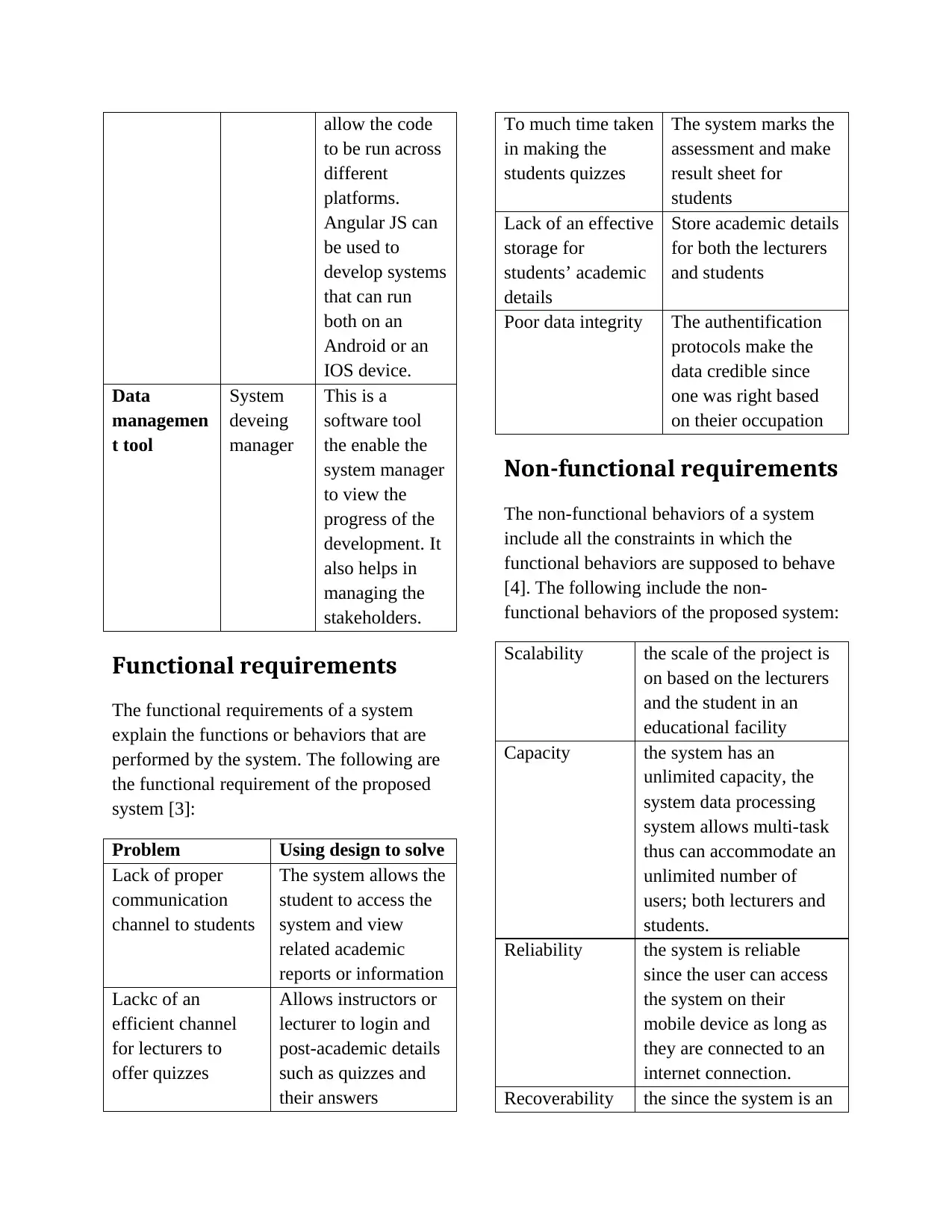
allow the code
to be run across
different
platforms.
Angular JS can
be used to
develop systems
that can run
both on an
Android or an
IOS device.
Data
managemen
t tool
System
deveing
manager
This is a
software tool
the enable the
system manager
to view the
progress of the
development. It
also helps in
managing the
stakeholders.
Functional requirements
The functional requirements of a system
explain the functions or behaviors that are
performed by the system. The following are
the functional requirement of the proposed
system [3]:
Problem Using design to solve
Lack of proper
communication
channel to students
The system allows the
student to access the
system and view
related academic
reports or information
Lackc of an
efficient channel
for lecturers to
offer quizzes
Allows instructors or
lecturer to login and
post-academic details
such as quizzes and
their answers
To much time taken
in making the
students quizzes
The system marks the
assessment and make
result sheet for
students
Lack of an effective
storage for
students’ academic
details
Store academic details
for both the lecturers
and students
Poor data integrity The authentification
protocols make the
data credible since
one was right based
on theier occupation
Non-functional requirements
The non-functional behaviors of a system
include all the constraints in which the
functional behaviors are supposed to behave
[4]. The following include the non-
functional behaviors of the proposed system:
Scalability the scale of the project is
on based on the lecturers
and the student in an
educational facility
Capacity the system has an
unlimited capacity, the
system data processing
system allows multi-task
thus can accommodate an
unlimited number of
users; both lecturers and
students.
Reliability the system is reliable
since the user can access
the system on their
mobile device as long as
they are connected to an
internet connection.
Recoverability the since the system is an
to be run across
different
platforms.
Angular JS can
be used to
develop systems
that can run
both on an
Android or an
IOS device.
Data
managemen
t tool
System
deveing
manager
This is a
software tool
the enable the
system manager
to view the
progress of the
development. It
also helps in
managing the
stakeholders.
Functional requirements
The functional requirements of a system
explain the functions or behaviors that are
performed by the system. The following are
the functional requirement of the proposed
system [3]:
Problem Using design to solve
Lack of proper
communication
channel to students
The system allows the
student to access the
system and view
related academic
reports or information
Lackc of an
efficient channel
for lecturers to
offer quizzes
Allows instructors or
lecturer to login and
post-academic details
such as quizzes and
their answers
To much time taken
in making the
students quizzes
The system marks the
assessment and make
result sheet for
students
Lack of an effective
storage for
students’ academic
details
Store academic details
for both the lecturers
and students
Poor data integrity The authentification
protocols make the
data credible since
one was right based
on theier occupation
Non-functional requirements
The non-functional behaviors of a system
include all the constraints in which the
functional behaviors are supposed to behave
[4]. The following include the non-
functional behaviors of the proposed system:
Scalability the scale of the project is
on based on the lecturers
and the student in an
educational facility
Capacity the system has an
unlimited capacity, the
system data processing
system allows multi-task
thus can accommodate an
unlimited number of
users; both lecturers and
students.
Reliability the system is reliable
since the user can access
the system on their
mobile device as long as
they are connected to an
internet connection.
Recoverability the since the system is an
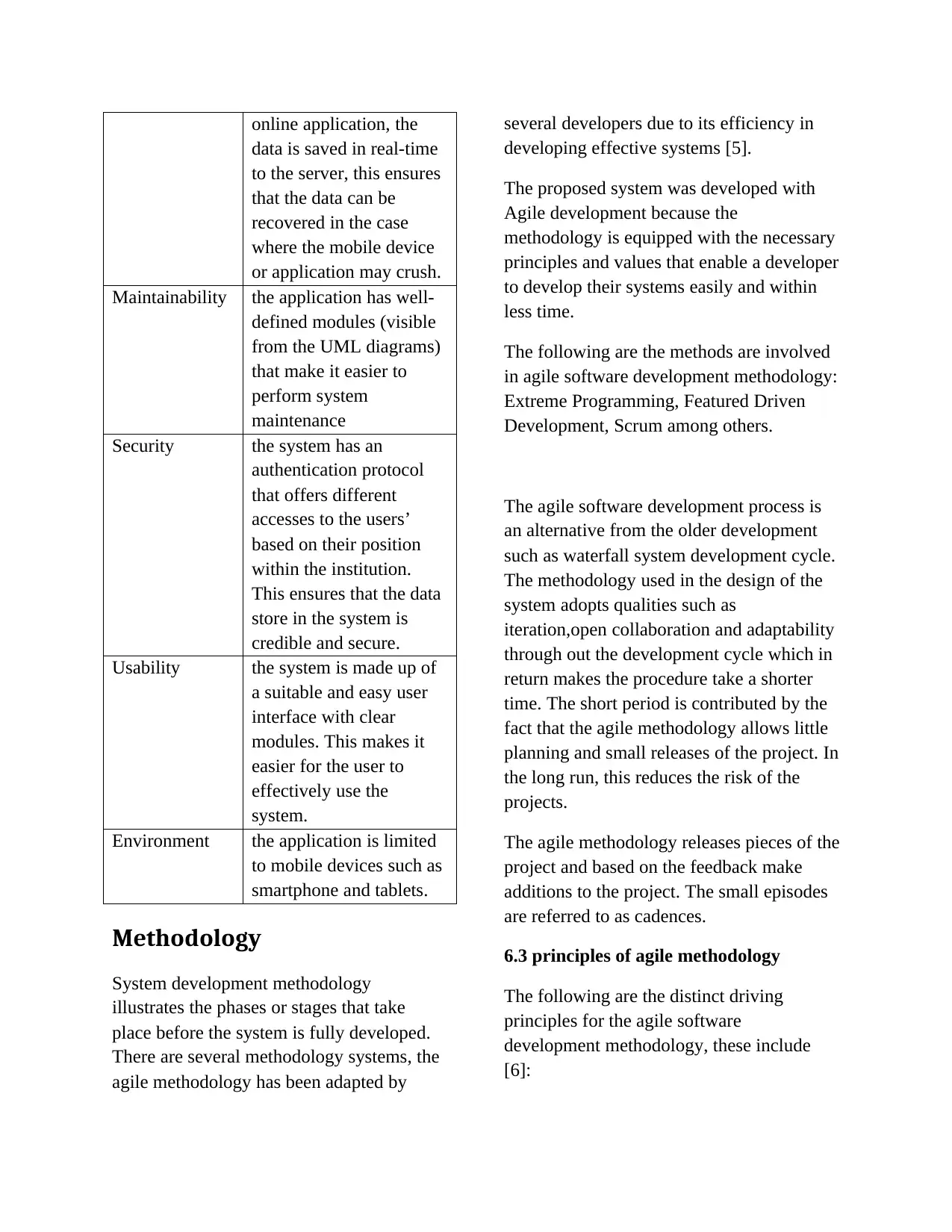
online application, the
data is saved in real-time
to the server, this ensures
that the data can be
recovered in the case
where the mobile device
or application may crush.
Maintainability the application has well-
defined modules (visible
from the UML diagrams)
that make it easier to
perform system
maintenance
Security the system has an
authentication protocol
that offers different
accesses to the users’
based on their position
within the institution.
This ensures that the data
store in the system is
credible and secure.
Usability the system is made up of
a suitable and easy user
interface with clear
modules. This makes it
easier for the user to
effectively use the
system.
Environment the application is limited
to mobile devices such as
smartphone and tablets.
Methodology
System development methodology
illustrates the phases or stages that take
place before the system is fully developed.
There are several methodology systems, the
agile methodology has been adapted by
several developers due to its efficiency in
developing effective systems [5].
The proposed system was developed with
Agile development because the
methodology is equipped with the necessary
principles and values that enable a developer
to develop their systems easily and within
less time.
The following are the methods are involved
in agile software development methodology:
Extreme Programming, Featured Driven
Development, Scrum among others.
The agile software development process is
an alternative from the older development
such as waterfall system development cycle.
The methodology used in the design of the
system adopts qualities such as
iteration,open collaboration and adaptability
through out the development cycle which in
return makes the procedure take a shorter
time. The short period is contributed by the
fact that the agile methodology allows little
planning and small releases of the project. In
the long run, this reduces the risk of the
projects.
The agile methodology releases pieces of the
project and based on the feedback make
additions to the project. The small episodes
are referred to as cadences.
6.3 principles of agile methodology
The following are the distinct driving
principles for the agile software
development methodology, these include
[6]:
data is saved in real-time
to the server, this ensures
that the data can be
recovered in the case
where the mobile device
or application may crush.
Maintainability the application has well-
defined modules (visible
from the UML diagrams)
that make it easier to
perform system
maintenance
Security the system has an
authentication protocol
that offers different
accesses to the users’
based on their position
within the institution.
This ensures that the data
store in the system is
credible and secure.
Usability the system is made up of
a suitable and easy user
interface with clear
modules. This makes it
easier for the user to
effectively use the
system.
Environment the application is limited
to mobile devices such as
smartphone and tablets.
Methodology
System development methodology
illustrates the phases or stages that take
place before the system is fully developed.
There are several methodology systems, the
agile methodology has been adapted by
several developers due to its efficiency in
developing effective systems [5].
The proposed system was developed with
Agile development because the
methodology is equipped with the necessary
principles and values that enable a developer
to develop their systems easily and within
less time.
The following are the methods are involved
in agile software development methodology:
Extreme Programming, Featured Driven
Development, Scrum among others.
The agile software development process is
an alternative from the older development
such as waterfall system development cycle.
The methodology used in the design of the
system adopts qualities such as
iteration,open collaboration and adaptability
through out the development cycle which in
return makes the procedure take a shorter
time. The short period is contributed by the
fact that the agile methodology allows little
planning and small releases of the project. In
the long run, this reduces the risk of the
projects.
The agile methodology releases pieces of the
project and based on the feedback make
additions to the project. The small episodes
are referred to as cadences.
6.3 principles of agile methodology
The following are the distinct driving
principles for the agile software
development methodology, these include
[6]:
Paraphrase This Document
Need a fresh take? Get an instant paraphrase of this document with our AI Paraphraser
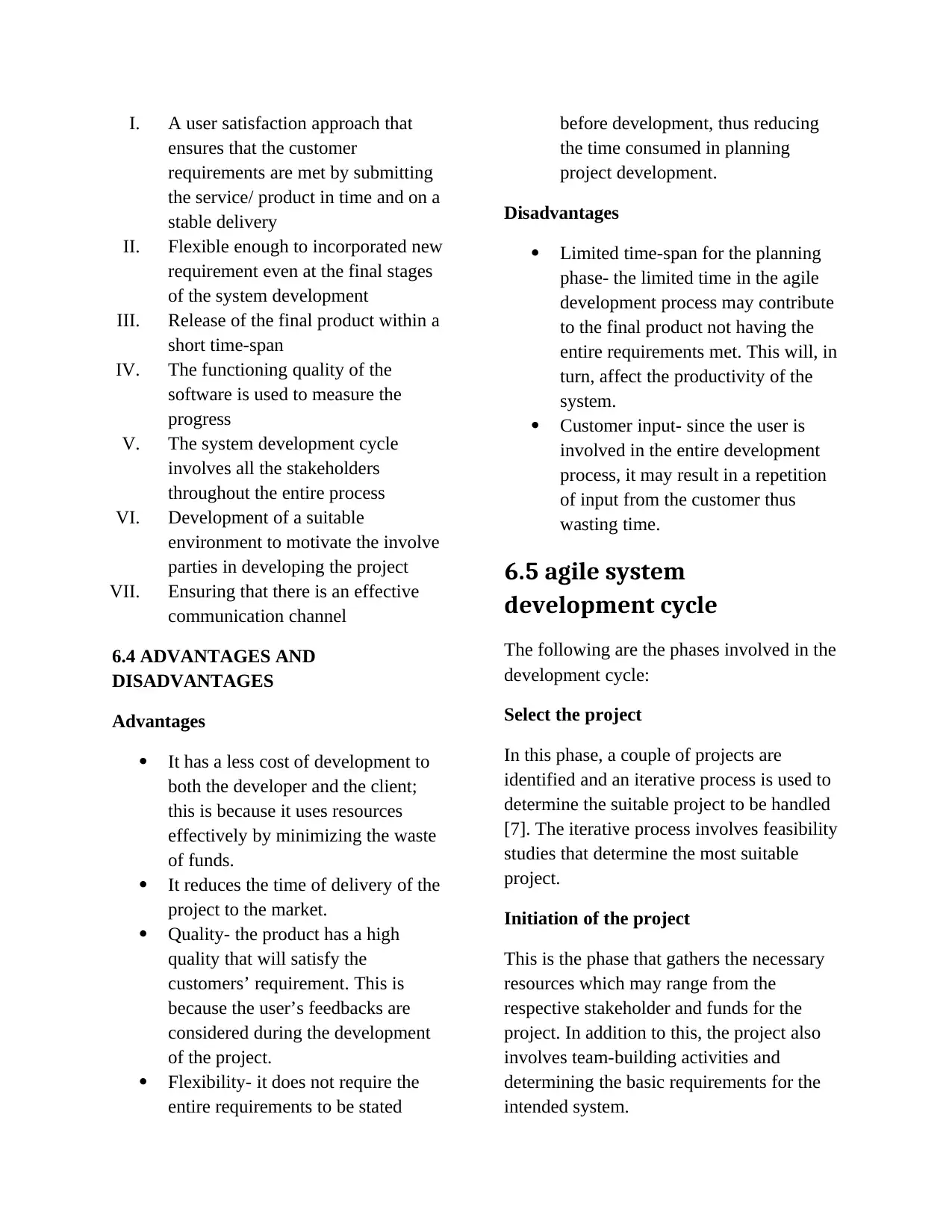
I. A user satisfaction approach that
ensures that the customer
requirements are met by submitting
the service/ product in time and on a
stable delivery
II. Flexible enough to incorporated new
requirement even at the final stages
of the system development
III. Release of the final product within a
short time-span
IV. The functioning quality of the
software is used to measure the
progress
V. The system development cycle
involves all the stakeholders
throughout the entire process
VI. Development of a suitable
environment to motivate the involve
parties in developing the project
VII. Ensuring that there is an effective
communication channel
6.4 ADVANTAGES AND
DISADVANTAGES
Advantages
It has a less cost of development to
both the developer and the client;
this is because it uses resources
effectively by minimizing the waste
of funds.
It reduces the time of delivery of the
project to the market.
Quality- the product has a high
quality that will satisfy the
customers’ requirement. This is
because the user’s feedbacks are
considered during the development
of the project.
Flexibility- it does not require the
entire requirements to be stated
before development, thus reducing
the time consumed in planning
project development.
Disadvantages
Limited time-span for the planning
phase- the limited time in the agile
development process may contribute
to the final product not having the
entire requirements met. This will, in
turn, affect the productivity of the
system.
Customer input- since the user is
involved in the entire development
process, it may result in a repetition
of input from the customer thus
wasting time.
6.5 agile system
development cycle
The following are the phases involved in the
development cycle:
Select the project
In this phase, a couple of projects are
identified and an iterative process is used to
determine the suitable project to be handled
[7]. The iterative process involves feasibility
studies that determine the most suitable
project.
Initiation of the project
This is the phase that gathers the necessary
resources which may range from the
respective stakeholder and funds for the
project. In addition to this, the project also
involves team-building activities and
determining the basic requirements for the
intended system.
ensures that the customer
requirements are met by submitting
the service/ product in time and on a
stable delivery
II. Flexible enough to incorporated new
requirement even at the final stages
of the system development
III. Release of the final product within a
short time-span
IV. The functioning quality of the
software is used to measure the
progress
V. The system development cycle
involves all the stakeholders
throughout the entire process
VI. Development of a suitable
environment to motivate the involve
parties in developing the project
VII. Ensuring that there is an effective
communication channel
6.4 ADVANTAGES AND
DISADVANTAGES
Advantages
It has a less cost of development to
both the developer and the client;
this is because it uses resources
effectively by minimizing the waste
of funds.
It reduces the time of delivery of the
project to the market.
Quality- the product has a high
quality that will satisfy the
customers’ requirement. This is
because the user’s feedbacks are
considered during the development
of the project.
Flexibility- it does not require the
entire requirements to be stated
before development, thus reducing
the time consumed in planning
project development.
Disadvantages
Limited time-span for the planning
phase- the limited time in the agile
development process may contribute
to the final product not having the
entire requirements met. This will, in
turn, affect the productivity of the
system.
Customer input- since the user is
involved in the entire development
process, it may result in a repetition
of input from the customer thus
wasting time.
6.5 agile system
development cycle
The following are the phases involved in the
development cycle:
Select the project
In this phase, a couple of projects are
identified and an iterative process is used to
determine the suitable project to be handled
[7]. The iterative process involves feasibility
studies that determine the most suitable
project.
Initiation of the project
This is the phase that gathers the necessary
resources which may range from the
respective stakeholder and funds for the
project. In addition to this, the project also
involves team-building activities and
determining the basic requirements for the
intended system.

Construction iteration
In this phase, the delivery of the system is
done where the user gives feedback based
on their experiences. The phase also
involves the following activities:
Model storming
Test-drive designs
Documentation and testing
Release iteration
This is the phase where the product is
delivered to the market for use. The phase
also involves completion of the
documentation as well as offering training to
the end-user on how to handle the system
effectively.
Production
This is also referred to the maintenance
phase; this is because if there are any errors
realized they are corrected. If no errors are
experienced, enhancements are carried out
in this phase
Retirement
This is the end game phase where the system
is deemed out of production and transferred
fully to the end-users. This phase also
involves the transition from the older
system.
Based on the used methodology it is evident
that agile methodology is more appropriate
for this system. In comparison to the
traditional method that emphasized more on
the processes, tools, and plans, the agile
methodology is more bent on the interaction
between the stakeholders. The methodology
has various advantages such as flexibility
that enable restructuring of the system at any
particular phase.
The agile methodology is proven to be the
best methodology for this system because of
its well-defined principles that ensure it is
strategic in developing the system.
Conclusion
From the above report, the system
requirements have been documented. The
functional requirements depict the behaviors
expected from the developed system while
the non-functional requirements show the
constraint of this behaviour. In addition to
that, the hardware and software
requirements need for the development of
the system have also been stated.
For a system to be successful there has to be
a stipulated methodology that determines the
flow of activities. Form the above report, the
agile method of system development has
been explained. The methodology and
system requirement from the report were
used to develop the system.
The proposed system will have a major
impact on the normal functioning of the
institutions, this includes unlimited access to
the respective portal thus saving time. In
addition to that, the student will improve
since they can easily access the system,
perform quizzes and get their performance
chart from a centralized point .
In this phase, the delivery of the system is
done where the user gives feedback based
on their experiences. The phase also
involves the following activities:
Model storming
Test-drive designs
Documentation and testing
Release iteration
This is the phase where the product is
delivered to the market for use. The phase
also involves completion of the
documentation as well as offering training to
the end-user on how to handle the system
effectively.
Production
This is also referred to the maintenance
phase; this is because if there are any errors
realized they are corrected. If no errors are
experienced, enhancements are carried out
in this phase
Retirement
This is the end game phase where the system
is deemed out of production and transferred
fully to the end-users. This phase also
involves the transition from the older
system.
Based on the used methodology it is evident
that agile methodology is more appropriate
for this system. In comparison to the
traditional method that emphasized more on
the processes, tools, and plans, the agile
methodology is more bent on the interaction
between the stakeholders. The methodology
has various advantages such as flexibility
that enable restructuring of the system at any
particular phase.
The agile methodology is proven to be the
best methodology for this system because of
its well-defined principles that ensure it is
strategic in developing the system.
Conclusion
From the above report, the system
requirements have been documented. The
functional requirements depict the behaviors
expected from the developed system while
the non-functional requirements show the
constraint of this behaviour. In addition to
that, the hardware and software
requirements need for the development of
the system have also been stated.
For a system to be successful there has to be
a stipulated methodology that determines the
flow of activities. Form the above report, the
agile method of system development has
been explained. The methodology and
system requirement from the report were
used to develop the system.
The proposed system will have a major
impact on the normal functioning of the
institutions, this includes unlimited access to
the respective portal thus saving time. In
addition to that, the student will improve
since they can easily access the system,
perform quizzes and get their performance
chart from a centralized point .
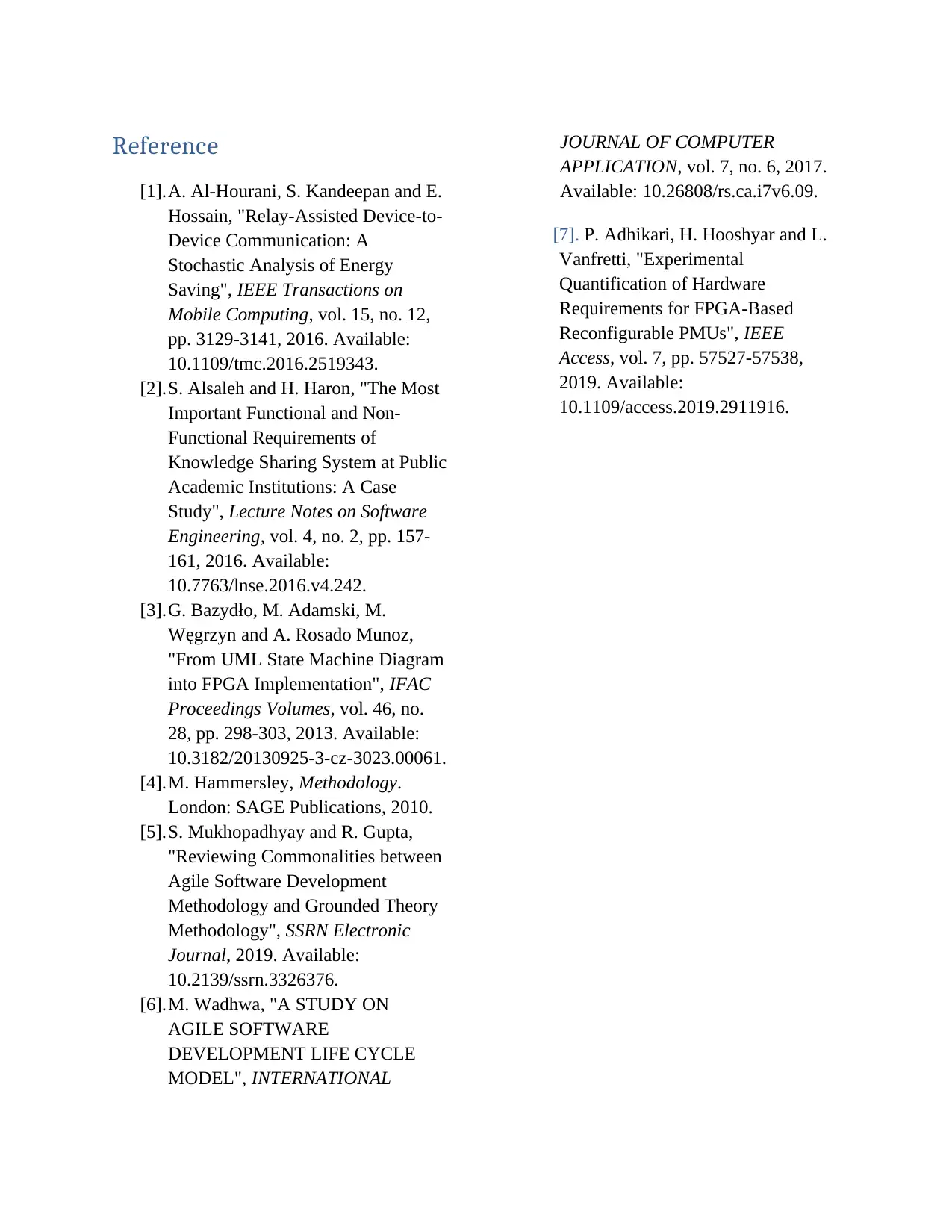
Reference
[1].A. Al-Hourani, S. Kandeepan and E.
Hossain, "Relay-Assisted Device-to-
Device Communication: A
Stochastic Analysis of Energy
Saving", IEEE Transactions on
Mobile Computing, vol. 15, no. 12,
pp. 3129-3141, 2016. Available:
10.1109/tmc.2016.2519343.
[2].S. Alsaleh and H. Haron, "The Most
Important Functional and Non-
Functional Requirements of
Knowledge Sharing System at Public
Academic Institutions: A Case
Study", Lecture Notes on Software
Engineering, vol. 4, no. 2, pp. 157-
161, 2016. Available:
10.7763/lnse.2016.v4.242.
[3].G. Bazydło, M. Adamski, M.
Węgrzyn and A. Rosado Munoz,
"From UML State Machine Diagram
into FPGA Implementation", IFAC
Proceedings Volumes, vol. 46, no.
28, pp. 298-303, 2013. Available:
10.3182/20130925-3-cz-3023.00061.
[4].M. Hammersley, Methodology.
London: SAGE Publications, 2010.
[5].S. Mukhopadhyay and R. Gupta,
"Reviewing Commonalities between
Agile Software Development
Methodology and Grounded Theory
Methodology", SSRN Electronic
Journal, 2019. Available:
10.2139/ssrn.3326376.
[6].M. Wadhwa, "A STUDY ON
AGILE SOFTWARE
DEVELOPMENT LIFE CYCLE
MODEL", INTERNATIONAL
JOURNAL OF COMPUTER
APPLICATION, vol. 7, no. 6, 2017.
Available: 10.26808/rs.ca.i7v6.09.
[7]. P. Adhikari, H. Hooshyar and L.
Vanfretti, "Experimental
Quantification of Hardware
Requirements for FPGA-Based
Reconfigurable PMUs", IEEE
Access, vol. 7, pp. 57527-57538,
2019. Available:
10.1109/access.2019.2911916.
[1].A. Al-Hourani, S. Kandeepan and E.
Hossain, "Relay-Assisted Device-to-
Device Communication: A
Stochastic Analysis of Energy
Saving", IEEE Transactions on
Mobile Computing, vol. 15, no. 12,
pp. 3129-3141, 2016. Available:
10.1109/tmc.2016.2519343.
[2].S. Alsaleh and H. Haron, "The Most
Important Functional and Non-
Functional Requirements of
Knowledge Sharing System at Public
Academic Institutions: A Case
Study", Lecture Notes on Software
Engineering, vol. 4, no. 2, pp. 157-
161, 2016. Available:
10.7763/lnse.2016.v4.242.
[3].G. Bazydło, M. Adamski, M.
Węgrzyn and A. Rosado Munoz,
"From UML State Machine Diagram
into FPGA Implementation", IFAC
Proceedings Volumes, vol. 46, no.
28, pp. 298-303, 2013. Available:
10.3182/20130925-3-cz-3023.00061.
[4].M. Hammersley, Methodology.
London: SAGE Publications, 2010.
[5].S. Mukhopadhyay and R. Gupta,
"Reviewing Commonalities between
Agile Software Development
Methodology and Grounded Theory
Methodology", SSRN Electronic
Journal, 2019. Available:
10.2139/ssrn.3326376.
[6].M. Wadhwa, "A STUDY ON
AGILE SOFTWARE
DEVELOPMENT LIFE CYCLE
MODEL", INTERNATIONAL
JOURNAL OF COMPUTER
APPLICATION, vol. 7, no. 6, 2017.
Available: 10.26808/rs.ca.i7v6.09.
[7]. P. Adhikari, H. Hooshyar and L.
Vanfretti, "Experimental
Quantification of Hardware
Requirements for FPGA-Based
Reconfigurable PMUs", IEEE
Access, vol. 7, pp. 57527-57538,
2019. Available:
10.1109/access.2019.2911916.
1 out of 10
Related Documents
Your All-in-One AI-Powered Toolkit for Academic Success.
+13062052269
info@desklib.com
Available 24*7 on WhatsApp / Email
![[object Object]](/_next/static/media/star-bottom.7253800d.svg)
Unlock your academic potential
© 2024 | Zucol Services PVT LTD | All rights reserved.





